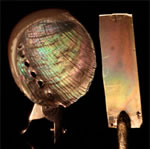
Scientists
have tried and tried to recreate nacre or mother of pearl, the iridescent
material in the inner shell of many mollusks. Their attempts in copying
nature have failed ... until now:
The previous attempts to make artificial nacre failed largely because
the alternating layers of material didn't hold together—sort of
like plywood with bad glue. In the latest research, the scientists solved
this delamination problem by alternatively dipping a sheet of material
into solutions of a vinyl polymer and an acrylic acid. They then dissolved
the dried acid and hardened the remaining polymers by exposing them
to ultraviolet light. Finally, the team slathered the porous surface
with a noncrystalline form of calcium carbonate, which infiltrated the
material and then slowly crystallized when placed in a container of
humid air. By repeating this sequence of steps, the researchers created
a multilayered coating (on strip at right above) that
is tougher and even more iridescent than natural mother-of-pearl.
 Scientists
have tried and tried to recreate nacre or mother of pearl, the iridescent
material in the inner shell of many mollusks. Their attempts in copying
nature have failed ... until now:
Scientists
have tried and tried to recreate nacre or mother of pearl, the iridescent
material in the inner shell of many mollusks. Their attempts in copying
nature have failed ... until now:
No comments:
Post a Comment